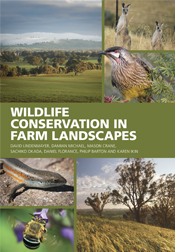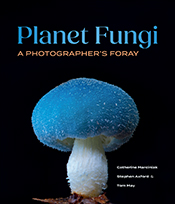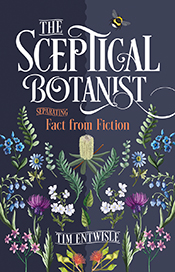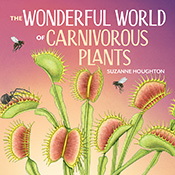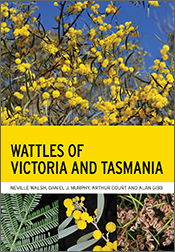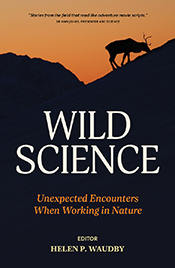Wildlife Conservation in Farm Landscapes

By: David Lindenmayer, Damian Michael, Mason Crane, Sachiko Okada, Daniel Florance, Philip Barton, Karen Ikin
Novel perspectives on integrating farming practices and wildlife conservation and other environmental values.
An increasing number of Australians want to be assured that the food and fibre being produced on this continent have been grown and harvested in an ecologically sustainable way. Ecologically sustainable farming conserves the array of species that are integral to key ecological processes such as pollination, seed dispersal, natural pest control and the decomposition of waste. + Full description
Wildlife Conservation in Farm Landscapes communicates new scientific information about best practice ways to integrate conservation and agriculture in the temperate eucalypt woodland belt of eastern Australia. It is based on the large body of scientific literature in this field, as well as long-term studies at 790 permanent sites on over 290 farms extending throughout Victoria, New South Wales and south-east Queensland.
Richly illustrated, with chapters on birds, mammals, reptiles, invertebrates and plants, this book illustrates how management interventions can promote nature conservation and what practices have the greatest benefit for biodiversity. Together the new insights in this book inform whole-of-farm planning.
Wildlife Conservation in Farm Landscapes is an ideal resource for land managers and farmers interested in integrating farming and environmental values and anyone interested in biodiversity in woodlands and agricultural zones.
Recipient of a 2017 Whitley Awards Certificate of Commendation for Conservation in Action
- Short descriptionReviews
"Wildlife Conservation in Farm Landscapes explores ecologically sustainable farming in short and concise chapters, but manages to do so without sparing the science or importance of each topic... This book will prove valuable to anyone managing agricultural land, but is also an excellent read just for interest's sake."
Emma Walsh, Wild Melbourne (blog), 20/10/16
"This is an immensely attractive and informative book... an outstanding book for farmers, land managers and bush lovers of all stripes."
Bill Hempel, Park Watch, 266, September 2016, p. 36
"This book is an excellent publication to provide a digestible overview of a large body of scientific work as it applies to the selected landscapes, mainly woodland environments. In a couple of days' intriguing reading, the reader will become aware of a wide range of factors that can influence the success of programs to improve the biological diversity of farm landscapes."
Michael Banyard, Wild Side (Newsletter of the Australian Veterinary Conservation Biology Special Interest Group), Spring 2016, p. 4
"Richly illustrated, with chapters on birds, mammals, reptiles, invertebrates and plants, this book illustrates how management interventions can promote nature conservation and what practices have the greatest benefit for biodiversity... an invaluable tool for anyone associated with a rural lifestyle."
LM, Talking Birds, October 2016, p. 21
"I feel sure that this book will be useful to those who work the land and is likely to be of interest to anyone who likes to broaden their perspectives on our environment."
Gil Porter, Warbler, September 2016, pp. 22-23
"this book provides detailed and proven success stories to enable better informed individuals, communities and organisations for future generations... I have no doubt you will gain appreciation for the absolute need to integrate farming with conservation and conservation with farming as a result of reading this book."
Stephani Grove, Land for Wildlife South East Queensland, April 2017, p. 13
"The book will be a welcome addition to the bookshelves of all those involved with sustainable land management."
Paul Adam, Australasian Plant Conservation, December 2016
Details
Paperback | August 2016 | $ 49.95ISBN: 9781486303106 | 232 pages | 245 x 170 mm
Publisher: CSIRO Publishing
Colour photographs, Illustrations
ePDF | August 2016
ISBN: 9781486303113
Publisher: CSIRO Publishing
Available from eRetailers
ePUB | August 2016
ISBN: 9781486303120
Publisher: CSIRO Publishing
Available from eRetailers
Features
- New and novel perspectives on integrating farming practices and wildlife conservation and other environmental values.
- Spectacular images of restored and well-managed agricultural landscapes and the biota characteristic of these areas.
- Significant practical new information on the best ways to tackle issues associated with protecting areas of remnant native vegetation, replanting/restoring native vegetation and other approaches to the integration of conservation and agricultural production.
Contents
PrefaceAcknowledgements
1. Introduction
2. Birds
3. Mammals
4. Reptiles
5. Invertebrates
6. Vegetation cover and Plants
7. Managing wildlife friendly farms
8. General discussion
Appendix 1: References
Appendix 2: Common and scientific names
Index
View the full table of contents (PDF).
Authors
David Lindenmayer is a Research Professor at the Fenner School of Environment and Society, the Australian National University. He has written more than 990 scientific articles (including 520 papers in peer-reviewed international journals) and 41 books on forest ecology and management, forest and woodland biodiversity, conservation in agricultural landscapes, the ecology and management of fire, and conservation science and natural resource management. He is one of the most highly cited ecological scientists in the world (listed in the top 0.1% in his field) and one of less than 1% of >15 million scientists globally that publish more than 10 peer-reviewed articles annually. He is a member of the Australian Academy of Science and the New York Academy of Science, winner of the Eureka Prize (twice), Whitley Award (six times), the Australian Natural History Medal, the Serventy Medal for Ornithology and numerous other awards. David was awarded a prestigious 5-year Australian Research Council Laureate Fellowship in 2013 and an Order of Australia in 2014. He currently runs five large-scale, long-term research programs in south-eastern Australia, primarily associated with developing ways to conserve biodiversity in reserves, national parks, wood production forests, plantations and on farm land.
Damian Michael is a senior research officer in ecology at the Fenner School of Environment and Society, the Australian National University. Damian completed his PhD on the ecology and conservation of reptiles in rocky outcrop ecosystems and is currently the project manager of several long-term biodiversity monitoring programs in south-eastern Australia. Damian’s research interests include understanding the effects of agriculture on the distribution and spatial ecology of reptiles, and evaluating the response of reptiles to habitat restoration and woodland management interventions. Damian is passionate about science communication and is the author of Reptiles of the NSW Murray Catchment.
Mason Crane has been a field-based research officer with the Fenner School of Environment and Society at the Australian National University for the last 15 years. During this time he has implemented and worked across numerous research projects examining biodiversity conservation in agricultural landscapes. Mason’s main responsibility is to coordinate research programs associated with the South West Slopes Restoration Study. While having a broad interest in ecology and a wide range of taxa, Mason is in the final stages of a PhD program focusing on the conservation of the Squirrel Glider.
Sachiko Okada is a senior research officer at the Fenner School of Environment and Society at the Australian National University. She manages a project of the Nanangroe Natural Experiment that investigates animal responses to land that has been transformed from grazing farms to radiata pine plantations. She is particularly interested in birds and is currently researching how landscape conversion affects bird breeding success in the region.
Daniel Florance has a strong interest in the conservation of our native ecosystems, using scientific research to provide practical evidence-based solutions to effectively implement conservation within the agricultural landscape. Daniel began working for the Lachlan Catchment Management Authority alongside the Lindenmayer research group on the ecological monitoring of the Australian Government's Environmental Stewardship Program in 2011 and he now manages this program. Since 2012, he has worked as a research officer at the Fenner School of Environment and Society at the Australian National University, where he is responsible for field-based, long-term ecological research in south-east Australia.
Philip Barton is a community ecologist interested in the drivers of insect diversity in box-gum grassy woodlands. He has previously studied how insects respond to grazing, woody debris, restoration plantings and fire, and is now studying insects associated with dead animals and how these insects contribute to the decomposition process.
Karen Ikin is a postdoctoral fellow with the ARC Centre of Excellence for Environmental Decisions, based at the Fenner School of Environment and Society, the Australian National University. Her research focuses on wildlife and habitat conservation in human-modified environments, such as those that occur in urban and agricultural landscapes. Karen is particularly interested in how ecological knowledge can be applied to improve conservation, management and planning.

